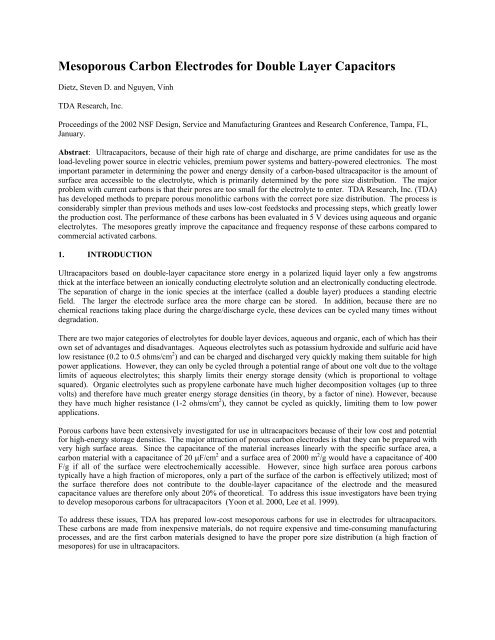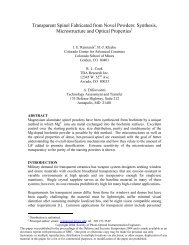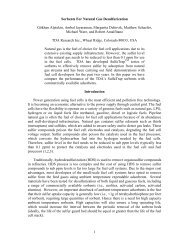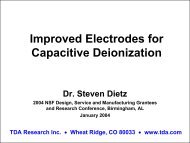Mesoporous Carbon Electrodes for Double Layer Capacitors
Mesoporous Carbon Electrodes for Double Layer Capacitors
Mesoporous Carbon Electrodes for Double Layer Capacitors
Create successful ePaper yourself
Turn your PDF publications into a flip-book with our unique Google optimized e-Paper software.
2. ULTRACAPACITOR APPLICATIONSThere are three major markets where ultracapacitors are needed, each having their own specific requirements. Theseare automotive, consumer electronics and industrial power management (Nickerson 1999).The automotive market wants to use ultracapacitors as load-leveling devices with batteries in electric and hybridvehicles. The minimum requirements are energies densities of >10 Wh/kg, power densities of >1000 W/kg and lowcost. To meet these requirements, the electrode materials must based on carbons to keep cost down and organicelectrolytes to reach the energy density goals. Maxwell Technologies (San Diego) currently has the best devices <strong>for</strong>this application; their per<strong>for</strong>mance is 4 Wh/kg and 500 W/kg. To meet the per<strong>for</strong>mance goals the capacitance of theelectrodes need to be increased from 70 to 125 F/g and the thickness of the electrodes reduced from 0.35 mm to 0.10mm (Burke 1999). Thin electrodes are needed because thinner electrodes allow quicker ion transport through theporous electrode resulting in increased power. Since Maxwell’s devices use carbon cloth electrodes it is notpossible to produce such thin electrodes. The only ways to produce such thin electrodes is by using carbon powderwith a binder. The problem is that currently carbon powders do not have high enough capacitance in organicelectrolytes because they do not have the proper pore size distribution.The consumer electronics market needs small high frequency devices to reduce the size of the batteries. Typicalapplications are pagers, personal data assistances and cell phones. The GSM phone will require a 200 Hz responsetime to improve the transmit burst in a digital phone system. In these devices high power is more important thanenergy density. There<strong>for</strong>e to get the desired frequency response, ultracapacitors will use aqueous electrolytesbecause of their much lower resistance. Also to attain these frequencies, the carbon electrodes need to be thin withlarge pores <strong>for</strong> rapid ion transport through the material.The industrial power market needs ultracapacitors <strong>for</strong> power quality, using ultracapacitors to handle power surgesand short-term power loss. Since electricity is transmitted at 60 or 120 Hz, this market also needs high frequencydevices based on aqueous electrodes, but on a much larger scale.Based on these market requirements, the goals of this project are to develop thin monolithic carbon electrodes withhigh mesoporosity at a low cost. With this combination of properties we will be able to outper<strong>for</strong>m current carbonelectrodes in terms of energy density and power per<strong>for</strong>mance at a reasonable cost.3. TDA’s MESOPOROUS CARBONSIn Table 1, we show the characteristics of some of our monolithic mesoporous carbons. The general procedure is toprepare a polymer solution, gel the solution and carbonize the polymer with heating. The polymers are veryinexpensive as well as the processing steps (i.e. no supercritical extraction). We have found that we can preparecarbons in which the pore sizes range from mesoporous (4 nm) to macroporous (2000 nm), depending on the<strong>for</strong>mulation. For all the carbons, the total surface area is always greater than the liquid accessible surface area (>2nm) or the mesopore area as measured by nitrogen adsorption, indicating the presence of micropores <strong>for</strong>med by gasevolution during the carbonization process. The fraction of the total pore volume in the mesopore range (>2 nm) isapproximately 80%. In Figure 1 is shown an example of the typical Type 4 isotherm (that is characteristic ofmesoporous materials) and the bimodal pore size distribution of one of our carbons with a large pore centered a 9nm and the shoulder of the micropore peak that is cut off at 1.7 nm (which is the lower limit <strong>for</strong> the instrument).4. PROTOTYPE DEVICESTo determine the frequency response of our carbons in a practical device JME, Inc. assembled and tested a 5 Vprototype devices using one of our carbons and an aqueous electrolyte and organic electrolyte. A 5 V device couldbe used in conjunction with a lithium or metal hydride battery that are rated at 3.6 to 4.2 V and are typically used insmall electronic devices such as cell phones.The carbon had 20 nm mesopores and a surface area of 1000 m 2 /g. The electrodes were made from the powderedcarbon and 3% binder (2 mil thick). The electrolyte was 38% sulfuric acid and the device had six cells to achieve 5volts.
Table 1. Properties of TDA’s mesoporous carbons.Sample Density(g/cm 3 )Mesopore Sizes(nm)Mesopore Area(m 2 /g)Total SurfaceArea (m 2 /g)TDA16 0.56 9 538 1493TDA20 0.60 20 437 998TDA30 0.60 22 178 870Figure 1. Isotherm and pore size distribution of a TDA mesoporous carbon TDA16.
Table 2. Test results <strong>for</strong> 5 V aqueous device.Measurements after 1.0 V conditioning <strong>for</strong> 10 min.1 kHz @ 1.0 V 30 min. IL (µA)ESR (Ω) C1000 (F) RC (sec) 2.5 V 3.75 V 5.0 V Bias0.161 0.048 0.0077 4.4 8.5 21.4C@ 20 mHz (F)0 V 2.5 V 3.75 V Bias 5.0 V Bias0.044 0.040 0.038 0.037F/g calculation using C @ 20 mHz values (dry carbon mass only)0 V Bias 2.5 V Bias 3.75 V Bias 5.0 V Bias173 157 149 1455 V AqueousDevice____0 V Bias…….2.5 V Bias----- 3.75 V Bias----- 5.0 V Bias410 HzFigure 2. Complex-plane impedance plot of 5 V aqueous device.
200 Hz5 V AqueousDevice____ 0 V Bias……. 2.5 V Bias----- 3.75 V Bias----- 5.0 V BiasFigure 3. Plot of capacitance versus frequency <strong>for</strong> 5 V aqueous device.Table 3. Test results <strong>for</strong> 5 V organic device.Measurements after 5.0 V conditioning <strong>for</strong> 10 min.1 kHz @ 1.0 V 30 min. IL (µA)ESR (Ω) C1000 (F) RC (sec) 2.5 V 3.75 V 5.0 V Bias4.33 0.048 0.21 2.7 5.9 14.1C@ 20 mHz (F)0 V 2.5 V 3.75 V Bias 5.0 V Bias0.04 0.047 0.05 0.053F/g calculation using C @ 20 mHz values (dry carbon mass only)0 V Bias 2.5 V Bias 3.75 V Bias 5.0 V Bias81 96 102 108
5 V OrganicDevice____0 V Bias…….2.5 V Bias----- 3.75 V Bias----- 5.0 V Bias4.9 HzFigure 4. Complex-plane impedance plot of 5 V organic device.2 Hz5 V OrganicDevice____ 0 V Bias……. 2.5 V Bias----- 3.75 V Bias----- 5.0 V BiasFigure 5. Plot of capacitance versus frequency <strong>for</strong> 5 V organic device.














